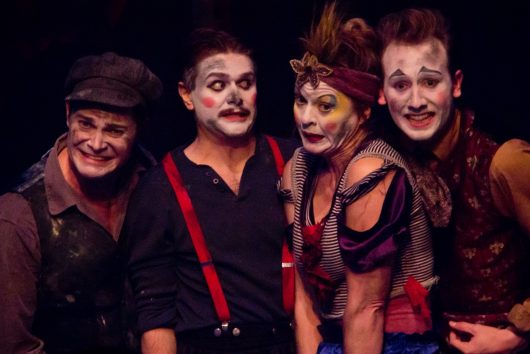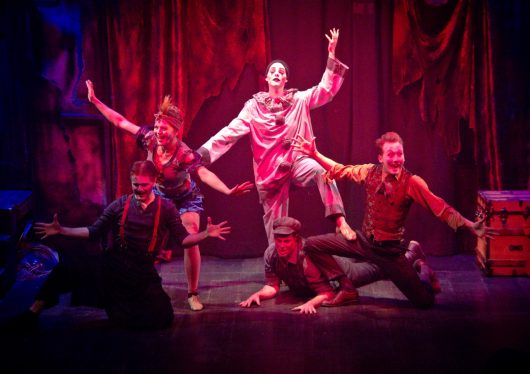Beauty from the ashes in Burning Bluebeard
Posted on December 17, 2016 By Colin MacLean Entertainment, Front Slider, Theatre
 If you are going to enjoy the unique Edmonton Actors Theatre Christmas neo-pantomime, Burning Bluebeard – until Dec. 24 at the Roxy on Gateway – there are a couple of points that in other circumstances might be regarded as “spoilers.” First of all, there will be no happy ending. Second, it is based on a massive tragedy that informs and infuses this melancholy, but highly entertaining evening.
If you are going to enjoy the unique Edmonton Actors Theatre Christmas neo-pantomime, Burning Bluebeard – until Dec. 24 at the Roxy on Gateway – there are a couple of points that in other circumstances might be regarded as “spoilers.” First of all, there will be no happy ending. Second, it is based on a massive tragedy that informs and infuses this melancholy, but highly entertaining evening.
On December 30, 1903 Chicago’s new state-af-the-art Iroquois Theatre caught fire in the middle of an afternoon performance of the British pantomime, Mr. Bluebeard. The popular show was being performed in front of a packed house – well over the legal limit of 1,602. They were mostly women and children. The owners, fearing that someone without a ticket might sneak in, locked the doors. The fire began when a light illuminating the moon sparked and set the drapes on fire. The star of the show, one of the reigning kings of vaudeville at the time, Eddy Foy, in a misguided effort to quell the resultant panic, exhorted patrons to return to their seats and many did. An asbestos curtain that was to have made the theatre fireproof was never deployed. Theatre engineer Robert Murray managed to pry open a locked back door so the performers could exit and the oxygen swept in and the whole theatre just went up. Six hundred people died. All the performers managed to escape – except one, an aerialist who got caught in her harness, and perished.
There was a lot of blame to go around, but one wonders how the performers lived with the fact that they were spared.
A few years back, a Chicago company, The Neo-Futurists, with the help of playwright Jay Torrence, turned these terrible events into an entertainment. It became a hit and is now produced each Christmas in Chicago. Dave Horak’s production in Edmonton last year was a high point of the season.
 The production imagines what the show they never gave might have looked like. The air is filled with smoke. The actors, charred and smeary, emerge from body bags. They perform with the sure knowledge of the terrible events that followed, but are propelled by a hope that the result may be different this time. John Ullyatt as Robert Murray, the rueful stage manager, cracks, “You know how when you go to a Christmas show and you’re sitting there and it doesn’t catch you on fire? We did the opposite of that.”
The production imagines what the show they never gave might have looked like. The air is filled with smoke. The actors, charred and smeary, emerge from body bags. They perform with the sure knowledge of the terrible events that followed, but are propelled by a hope that the result may be different this time. John Ullyatt as Robert Murray, the rueful stage manager, cracks, “You know how when you go to a Christmas show and you’re sitting there and it doesn’t catch you on fire? We did the opposite of that.”
They stage a ghostly version of the show on Scott Peter’s remarkable set – charred ruins of a burnt out theatre. The elements of panto are all there – a lip smacking villain and a fairy godmother, vaudevillian set pieces, a cheeky harlequin, and Christmas presents. There is also Icelandic electro-pop music, and Ullyat’a killer lip synch to Nell Carter’s I just Want to Go To Rehab, along with aerial acts and some impressive dancing. The antic comedian, another vaudevillian staple, delivers mouldy old jokes but instead of the usual “Take my wife – please!” the jokes here range to “this is the hottest show in town with a finale that really brings the house down.”
This funny and entertaining performance is thrown into a very different light by the existential realm in which it is placed. Burning Bluebeard successfully mixes horror and humour, pathos and hope – all held together by an abiding celebration of the magic of theatre.
I suspect that all of this could grow stale fairly quickly but not with this talented company of players. Dave Horak’s gung-ho, give ‘er-all production is unendingly innovative and constantly jolted into new life by his company of multi-talented performers; Braydon Dowler-Coltman, Vincent Forcier, Amber Lewis, Richelle Thoreson, Stephanie Wolfe and the protean Ullyatt. Each one has a moment and they all shine.
We know the ending, but these unquenchable performers with their irreverent wit, and buoyed by the ready rolling laughter that often convulses the audience, actually begin to generate some hope that the ending might somehow be different, that art can vanquish tragedy and the purgatory these restless souls inhabit will be exorcised by the act of finishing the show.
“We might get it right this time,” one of the players observes plaintively.
But time and history are not to be conquered. When the inexorable arrives – words fail and the enormity can only be expressed in Rachael Thorson’s emotionally charged choreography as the cast perform their dance of death. Then, finally, – fire, panic, then darkness and sound take the horror from the stage and into the mind. Even with that heart-wrenching ending, the age old catharsis of theatre remains, and beauty yet slumbers in the ashes.












